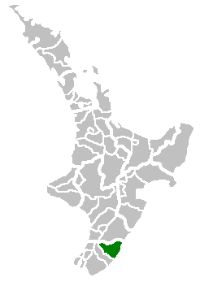Masterton, New Zealand
| Masterton District | |
|---|---|
| Territorial authority | |
 Location of Masterton District in North Island |
|
| Country |
|
| Region | Wellington |
| Territorial authority | Masterton District |
| Town founded | 1854 |
| Electorate | Wairarapa |
| Government | |
| • Mayor | Lyn Patterson |
| Area | |
| • Territorial | 2,299 km2 (888 sq mi) |
| • Urban | 100.66 km2 (38.87 sq mi) |
| Elevation | 111 m (364 ft) |
| Population (June 2016) | |
| • Territorial | 24,600 |
| • Density | 11/km2 (28/sq mi) |
| • Urban | 21,200 |
| • Urban density | 210/km2 (550/sq mi) |
| Time zone | NZST (UTC+12) |
| • Summer (DST) | NZDT (UTC+13) |
| Postcode | 5810 |
| Area code(s) | 06 |
| Website | www |
Masterton (Māori: Whakaoriori) is a large town and local government district in the Wellington Region of New Zealand. It is the largest town in the Wairarapa, a region separated from Wellington by the Rimutaka ranges. It is 100 kilometres north-east of Wellington, 39.4 kilometres south of Eketahuna, on the Ruamahanga River.
Masterton has an urban population of 21,200, and district population of 24,600 (June 2016).
The Wairarapa Line railway allows access to Wellington, Lower Hutt and Upper Hutt.
Masterton businesses include services for surrounding farmers. Three new industrial parks are being developed in Waingawa, Solway and Upper Plain. The town is the headquarters of the annual Golden Shears sheep-shearing competition.
Masterton suburbs include:
Masterton was founded in 1854 by the Small Farms Association. The association was led by Joseph Masters – after whom the town was named – and aimed to settle working people in villages and on the land. At first Masterton grew slowly, but as its farming hinterland became more productive it began to prosper. In the 1870s it overtook Greytown as Wairarapa’s major town. It became a borough in 1877 and was reached by the railway line from Wellington in 1880. This cemented the town’s position as the region’s main market and distribution centre.
In the 20th century Masterton kept growing, but never enough to dominate the region. From the 1960s, people and businesses left for opportunities elsewhere. In the 1980s, with government deregulation and protective tariffs lifted, more businesses closed and the town declined further.
In April 1965 one of the country's worst industrial accidents occurred at the General Plastics Factory.
It did not quite qualify to be a city by 1989 when the minimum population requirement for that status was lifted from 20,000 to 50,000.
...
Wikipedia
